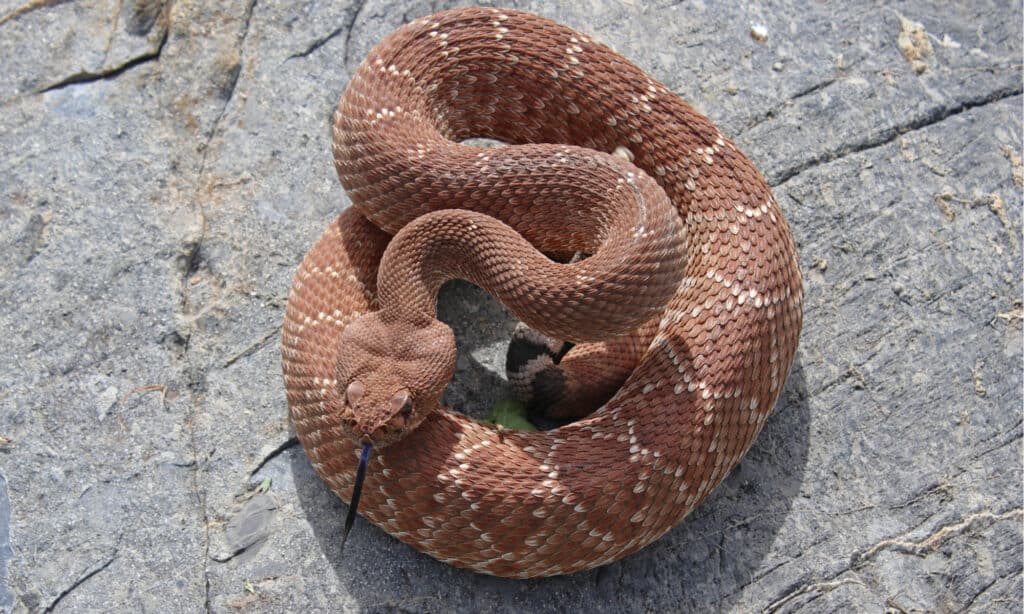Red Diamondback Rattlesnake
Crotalus ruber
A rattlesnake can shake its rattle back and forth 20-100 times per second.
Advertisement
Red Diamondback Rattlesnake Scientific Classification
- Kingdom
- Animalia
- Phylum
- Chordata
- Class
- Reptilia
- Order
- Squamata
- Family
- Viperidae
- Genus
- Crotalus
- Scientific Name
- Crotalus ruber
Read our Complete Guide to Classification of Animals.
Red Diamondback Rattlesnake Conservation Status
Red Diamondback Rattlesnake Facts
- Prey
- mice, rats, rabbits, squirrels, lizards, snakes
- Main Prey
- rodents
- Name Of Young
- neonate
- Group Behavior
- Solitary
- Fun Fact
- A rattlesnake can shake its rattle back and forth 20-100 times per second.
- Biggest Threat
- Habitat destruction, juveniles are susceptible to predation by roadrunners, other snakes, owls.
- Most Distinctive Feature
- Rattle and black & white bands on tail
- Other Name(s)
- Red diamond rattlesnake, red rattlesnake, red diamond snake, red diamond-backed rattlesnake, red rattler, and western diamond rattlesnake.
- Litter Size
- up to 25
- Habitat
- coastal scrub brush, desert
- Diet for this Fish
- Carnivore
- Average Litter Size
- 5-15
- Lifestyle
- Nocturnal
- Diurnal
- Common Name
- Red diamond rattlesnake
- Location
- Baja California and southwestern California, US
Red Diamondback Rattlesnake Physical Characteristics
- Color
- Grey
- Red
- Light-Brown
- Skin Type
- Scales
- Lifespan
- 13-15 years
- Venomous
- Yes
- Aggression
- Low
View all of the Red Diamondback Rattlesnake images!
The sound of a red diamondback rattlesnake’s tail may be disturbing, but they want you to go away!
Hikers often hear the disturbing sound of a rattlesnake in the brush near their path. However, this is the sound of a snake trying to warn you away! Red diamondback rattlesnakes are large-bodied venomous snakes; they live in the southwestern corner of California south to the tip of Baja California. This snake preys on rodents, squirrels, rabbits, lizards, and the occasional snake. They are easy to recognize by their diamond-shaped markings, angular head (some say rattlers have an angry expression), and the rattle at the end of their tail.
3 Amazing Facts About Red Diamondback Rattlesnakes
- Red diamond rattlesnakes develop more toxic venom as they mature. An adult’s venom can be six to 15 times more toxic than a juvenile’s venom.
- Some scientists believe that rattlesnakes evolved their rattle in the Great Plains region of North America to prevent being stepped on by bison.
- Their rattles are nested scales that are added to with each shed. They aren’t a way to tell a snake’s age because they often break.
Where to Find Red Diamondback Rattlesnakes
The red diamondback rattlesnake inhabits a wide range of habitats, including coastal foothills, desert slopes, and rocky canyons. It also inhabits lower woodlands and cultivated fields but avoids the desert floor and areas above 5,000 feet. Some of their range overlaps with the western diamondback, but this species has a redder, almost faded appearance in comparison with the western diamondback.
It occurs in the southwest corner of California south, to the tip of the Baja Peninsula. In addition, it also lives on the Pacific islands of Cedros and Santa Margarita and several islands in the Gulf of California. The red diamondback rattlesnake is mostly terrestrial and spends most of its time on the ground. It may hide in and under crevices in rocks and rodent burrows, when it feels threatened, and may only travel a couple of miles throughout its life.
Red Diamondback Rattlesnakes’ Scientific Name
Crotalus ruber is their scientific name; Crotalus has its origins in a Greek word, “krotalon” (κροταλον), which means rattle. Red diamondback rattlesnakes are one of several rattlesnake species.
They’re vipers in the Viperidae subfamily of Crotalinae, closely related to snakes like the cottonmouth and copperhead snakes. However, snakes in this genus of the subfamily are not only pit vipers but also have a series of nested scales at the tips of their tails called rattles.
Types of Diamondback Rattlesnakes
Currently, there are three species called diamondback rattlesnakes. The name comes from the diamond-shaped markings on their back. They occur all across the southern portions of the United States and northern Mexico.
- Western Diamondback Rattlesnake (Crotalus atrox) inhabits the southwest United States and northern Mexico
- Eastern Diamondback Rattlesnake (Crotalus adamanteus) occurs in the southeast United States
- Red Diamondback Rattlesnake (Crotalus ruber) has three recognized subspecies, Cedros Island red diamond rattlesnake (C. r. exsul), San Lucan red diamond rattlesnake (C. r. lucasensis), and the red diamond rattlesnake (C. r. ruber).
Population and Conservation Status of Red Diamondback Rattlesnakes
The IUCN assessed the red diamond rattlesnake in 2007 and determined it was “Least Concern,” with a slightly decreasing population. However, it’s under a lot of pressure from human encroachment, and people often kill them. They also face numerous threats as juveniles because several animals actively hunt them for their own meal. Hawks, weasels, king snakes, and other predators include these snakes in their diet.
The red diamondback rattlesnake’s preferred habitat, coastal scrub brush, has dramatically reduced over the years due to residential and commercial development. The California Department of Fish and Game considers them a Species of Special Concern because of habitat loss in coastal regions.
Red Diamondback Rattlesnakes: Appearance and Description
This species averages about two to three feet long as an adult; the males are usually longer than females and can reach nearly five feet in length. In many snake species, it’s the female that is longer, but in this and several other rattlesnake species, it’s reversed.
The red diamond rattlesnake has diamond-shaped blotches along the length of its back and a reddish tinge to its color. It’s born grayish and becomes redder as it matures. A diamondback rattlesnake tail has black and white bands that end at the rattle, giving it its name. Its head is sharply angular and twice the width of its neck, with elliptical pupils. There are light-colored stripes that start on either side of its eye, extending diagonally downwards.
It has hinged fangs and the snake tucks them up into its mouth when they don’t need them. The fangs are hollow and attached to venom glands that sit behind the snake’s eyes. If one of its fangs breaks, it grows back.
During the winter months, red diamondback rattlesnakes retreat to a den that they share with several others. In the spring, they emerge to warm up, fatten up and find a mate. The males battle for the right to mate with a female, and a few months afterward the female gives birth to between five and 15 young.
This snake can live for 15 or 16 years in the wild, and as many as 19 in captivity.

Red diamondback rattlesnakes coil up, rattle, and may strike when they’re threatened.
©Creeping Things/Shutterstock.com
Pictures and Videos of Red Diamondback Rattlesnakes

Diamondback rattlesnakes are easy to identify.
©reptiles4all/Shutterstock.com

Showing off that large, angular head, as it gets ready to strike.
©Creeping Things/Shutterstock.com
Venom: How Dangerous Are Red Diamondback Rattlesnakes?
Like other pit vipers, red diamondback rattlesnakes are venomous. However, bites are relatively rare, and their venom isn’t as dangerous as other species. Scientists observe that the content of a vipers’ venom varies depending upon their diet. In some areas, their venom contains more neurotoxins, and others more cytotoxins. Even though this species’ venom is less toxic, they often deliver a large quantity in each bite. A single bite can deliver three times the dose that can kill a fully grown human.
Interestingly, their venom toxicity increases as they mature. According to the University of California at Davis, the “tissue damaging properties of venom are six to 15 times greater in adults than juveniles.” This is contrary to what many believe.
This is sort of true. It’s more true to say that most snake species are just as toxic (if not more so) as adults as when they’re young. However, an adult is less likely to inject a full dose because they don’t plan on eating that person. They simply want to be left alone.
As damaging as their bite can be, bites aren’t very common.
Red Diamondback Rattlesnakes: Behavior and Humans
Red diamondback rattlesnakes feed on various animals such as mice, rats, rabbits, lizards, and other snakes. Snakes in coastal areas tend to eat larger prey, and those in desert areas tend to eat smaller prey; this could be based on availability or preference.
These ambush predators spend much of their time waiting for prey to come to them. They like finding a promising spot to wait and may spend many hours waiting for prey. This is where they’re most often found by someone. On the rare occasion that a red diamondback rattlesnake bites someone, it’s usually because someone stepped on, handled, or otherwise startled the snake.
This relatively mild-mannered snake may look angry, but it rarely bites humans. It’s far more likely to hide and try to remain unnoticed! However, if cornered, it will put up a defensive display that includes coiling, rattling, and striking.
Similar Animals
View all 114 animals that start with RRed Diamondback Rattlesnake FAQs (Frequently Asked Questions)
Are red diamondback rattlesnakes venomous?
Yes, although the venom isn’t as strong as that of other rattlesnakes, they inject a lot when they bite. Their venom also becomes more toxic to people as they mature.
How do red diamondback rattlesnakes hunt?
These, like many vipers, are ambush predators. This means that they find a good spot and wait for their meal to come to them.
Are red diamondback rattlesnakes aggressive?
Surprisingly, no. As angry as it seems to look, it’s more concerned with getting away from you than biting you.
Where do red diamondback rattlesnakes live?
These snakes live from the southern tip of Baja California all the way up to the southwestern corner of California in the United States.
What do red diamondback rattlesnakes eat?
This rattler eats a little of everything fuzzy. Most of them seem to prefer warm-blooded prey like rabbits, mice, rats, and birds if they can catch them; however, they also eat other snakes and lizards.
Thank you for reading! Have some feedback for us? Contact the AZ Animals editorial team.
Sources
- California Herps, Available here: http://www.californiaherps.com/snakes/pages/c.ruber.html
- Herp Atlas, Available here: http://herpatlas.sdnhm.org/species/overview/red-diamond-rattlesnake/210/
- Florida Museum, Available here: https://www.floridamuseum.ufl.edu/florida-snake-id/snake/eastern-diamond-backed-rattlesnake/
- Desert Museum, Available here: https://www.desertusa.com/reptiles/red-diamond-rattlesnake.html
- CA Fish & Game, Available here: https://map.dfg.ca.gov/metadata/ds1779.html

















